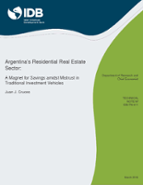Argentina's Residential Real Estate Sector: A Magnet for Savings amidst Mistrust in Traditional Investment Vehicles
Date
Mar 2016
This paper measures the flow of funds into the real estate sector for the city of Buenos Aires since 1992 and compares it to traditional savings instruments. For each dollar that went into the city's real estate from 1992 until 2000, about six dollars went into deposits in the national banking system. From 2003 until 2012, for each dollar that went into real estate, only 99 cents went to bank deposits. While the 2010 census reports a vacancy rate of 24 percent for the city, analysis of a micro data set on individual house electricity consumption suggests that the rate is only about 6 percent, in line with international standards. Increased supply, however, has resulted in a dramatic reduction of real rental values and rental yields. The paper concludes by estimating the welfare loss from allocating society's scarce capital to such a low-return activity, which is interpreted as a lower bound of the flow cost of mistrust in traditional savings instruments.



